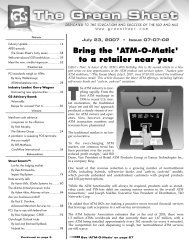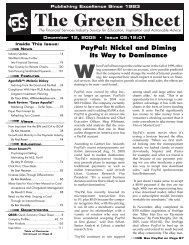View PDF of this issue - The Green Sheet
View PDF of this issue - The Green Sheet
View PDF of this issue - The Green Sheet
Create successful ePaper yourself
Turn your PDF publications into a flip-book with our unique Google optimized e-Paper software.
33<br />
channels that are currently not available to them if they<br />
rely fully on cash or money orders," she said.<br />
Unreached Prospects<br />
SellingPrepaid<br />
Understanding<br />
prepaid's target<br />
audience<br />
<strong>The</strong> unbanked and underbanked consumer segments<br />
are under increasing scrutiny to understand<br />
what they want and need in prepaid<br />
card products. In a December 2009 impact note<br />
entitled Prepaid Debit Cards: Barriers to Adoption, payments<br />
industry advisory Aite Group LLC analyzed why some<br />
consumers choose prepaid cards while others do not.<br />
In November and December 2008, Aite surveyed 400<br />
frequenters <strong>of</strong> eight check cashing stores in urban and rural<br />
communities in Virginia. For the purposes <strong>of</strong> its research,<br />
Aite delineated checking account holders (underbanked)<br />
from those that lacked checking accounts (unbanked). Aite<br />
then segmented respondents into five categories: adopters,<br />
rejectors, unreached prospects, purchase intenders and<br />
lapsed owners.<br />
Adopters<br />
This segment represented 30 percent <strong>of</strong> respondents.<br />
Aite found that adopters have embraced prepaid cards;<br />
not only do they try them but they reload them as well.<br />
According to Judy Fishman, Aite Analyst and co-author <strong>of</strong><br />
the report, adopters consider themselves technologically<br />
savvy and willing to try new things. Consequently, they<br />
have incorporated prepaid cards into their lives.<br />
Rejectors<br />
Unlike adopters, rejectors have no interest in prepaid<br />
cards; because they make up 43 percent <strong>of</strong> Aite's research,<br />
prepaid providers might take heed regarding why.<br />
"<strong>The</strong>y feel the cards are either a problem or a mystery,"<br />
Fishman said. "And they know about them. <strong>The</strong>y know<br />
they're there. But at <strong>this</strong> moment in time, they don't have<br />
any interest in trying them." Fishman attributed rejectors'<br />
reticence to a lack <strong>of</strong> technological sophistication, as<br />
opposed to lack <strong>of</strong> education. "I think the adopters are<br />
more willing to use products that are a little higher up in<br />
the hierarchy <strong>of</strong> complexity," she said.<br />
Fishman advises providers to reach rejectors by conveying<br />
to them clearly and concisely the benefits <strong>of</strong> prepaid cards,<br />
such as that they are safer to carry than cash. "And in what<br />
ways does it give them an opportunity to participate in<br />
Seventeen percent <strong>of</strong> research participants were put in<br />
the unreached prospects category. <strong>The</strong>se consumers are<br />
unaware <strong>of</strong> prepaid cards and tend to be both younger (25<br />
and under) and older (over 45) than adopters. <strong>The</strong>y are<br />
more involved with technology than rejectors but prefer<br />
to pay with cash.<br />
According to Fishman, for the younger unreached<br />
prospects, the idea <strong>of</strong> a prepaid debit card has not sunk in;<br />
for the older consumers, debit cards are a newer product<br />
and have yet to recognize prepaid cards as a natural<br />
extension to them.<br />
<strong>The</strong> report recommends mass marketing and in-store<br />
demonstrations as ways to familiarize unreached prospects<br />
with prepaid cards.<br />
Prioritize efforts<br />
<strong>The</strong> other two categories, purchase intenders (5 percent)<br />
and lapsed owners (4 percent) were not analyzed in the<br />
report because these groups are small and "appear to be<br />
already sensitive to the product [and] would be apt to be<br />
caught in a broad category," Fishman said.<br />
She recommends that prepaid card providers continue<br />
to reinforce brand and product adoption, as well as the<br />
reloading <strong>of</strong> the cards by adopters.<br />
Additionally, providers should focus on convincing<br />
unreached prospects to try prepaid cards by providing<br />
them simple and relevant information.<br />
Ciao prepaid<br />
As part <strong>of</strong> Retail Banking Research's Payment<br />
Cards Western Europe 2010 report, RBR tracked<br />
the development <strong>of</strong> the European prepaid card<br />
industry. While prepaid cards represent only a<br />
fraction <strong>of</strong> total card payments in the area, it is an industry<br />
on an overall upward trend, RBR said.<br />
According to Chris Herbert, Project Manager at RBR, 866<br />
million payment cards were in circulation in 2008 in the<br />
17 Western European countries surveyed. Of that total, 9<br />
million were prepaid cards. In 2008, 33 billion electronic<br />
transactions were made, with 21 billion using debit and<br />
prepaid cards, for a total value <strong>of</strong> just over 1 trillion euros,<br />
Herbert said.<br />
<strong>The</strong> Italiane way<br />
According to the RBR study, the leader in prepaid is<br />
clearly Italy, where 90 percent <strong>of</strong> prepaid cards in the<br />
region exist – roughly 8.2 million cards, or 9 percent <strong>of</strong>
















